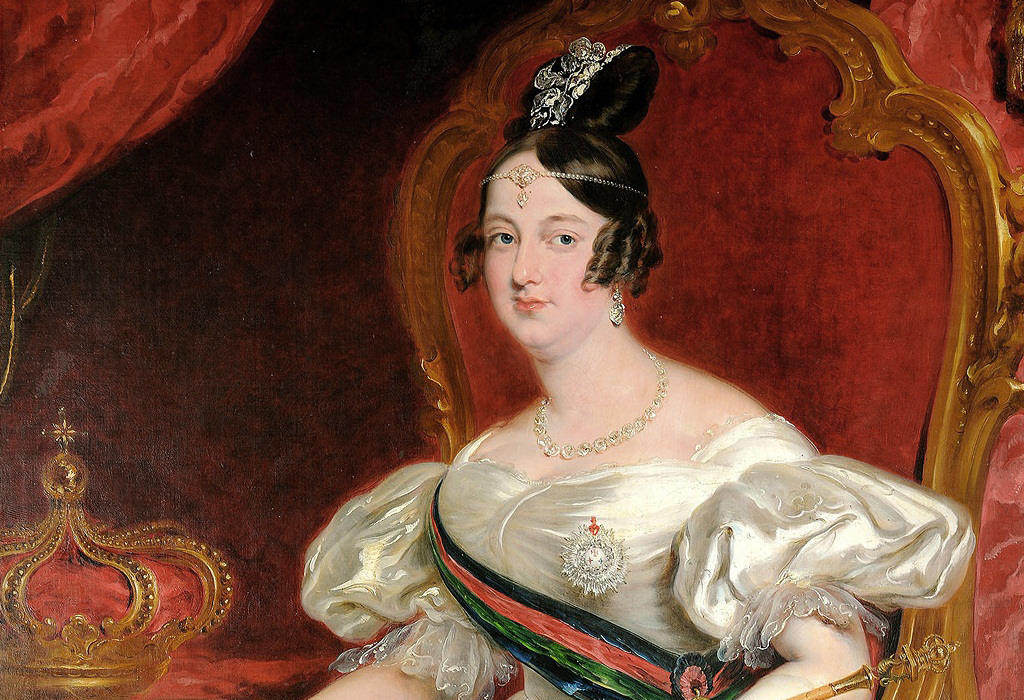Before his passing, King Dom João VI appointed his favorite daughter, Dona Isabel Maria, as regent until the legitimate heir returned to the kingdom. However, he failed to specify whether the rightful heir was Pedro or Miguel. Although most believed Pedro to be the legitimate heir, Brazil was reluctant to see the unification of Portugal and Brazil's thrones once again. In a bid for a more consensual solution, Pedro renounced his claim to the Portuguese throne in favor of his seven-year-old daughter Maria. The plan was for Maria to marry her uncle Miguel, who would act as a regent until she came of age, while also accepting the liberal constitution.
However, Miguel's true intentions were revealed when he immediately deposed Maria upon his arrival in Portugal and proclaimed himself king, disregarding the liberal constitution. Maria was then forced into exile and embarked on a journey through various European courts, including Vienna, London, and Paris. Despite Miguel's usurpation, Maria's supporters, along with her father, formed the liberal faction and initiated the Liberal Wars against Miguel's absolutist rule.
Maria's first reign was cut short by Miguel's absolutist uprising in 1828. This led to a period of conflict known as the Liberal Wars, which lasted until 1834 when Maria was eventually restored to the throne, and Miguel was exiled to Germany. During this period, Maria traveled extensively across Europe, seeking support for her cause and building alliances with other nations.
While in exile, Maria faced numerous challenges, including political opposition, lack of resources, and uncertainty about her future. Despite these obstacles, she showed remarkable resilience and determination. With the help of her father and loyal supporters, she orchestrated a successful campaign to regain control of Portugal. The decisive Battle of Cova da Piedade in 1833, followed by the Duke of Terceira's victorious entry into Lisbon, marked a turning point in favor of the liberals. Miguel was eventually forced to abdicate in 1834, leading to Maria's restoration to the throne.
After her return, Maria pursued various initiatives to consolidate her power and promote the well-being of her subjects. She married twice during her reign. Her first marriage was to Auguste, Duke of Leuchtenberg, the son of Eugène de Beauharnais and grandson of Empress Josephine of France. However, Auguste passed away just two months after their wedding in 1835.
In 1836, Maria married Prince Ferdinand of Saxe-Coburg and Gotha, a cultured and well-educated man who would become an influential figure in Portugal. The couple had eleven children, although only five survived infancy. Their marriage was marked by deep affection and mutual respect.
Maria's reign was not without its challenges. The revolutionary insurrection of 1846, known as the Maria da Fonte Revolt, posed a significant threat to her rule. The uprising, led by Maria da Fonte, a peasant woman, was fueled by discontent with political corruption, abuse of power, and economic hardships. Maria da Fonte's revolt was eventually suppressed, but it highlighted the need for reforms and social improvements.
Lisbon.vip Recommends
In terms of public health, Maria II faced significant challenges, particularly with recurring epidemics of cholera and tuberculosis. She actively worked to improve sanitation, establish hospitals, and provide medical care to the population. Her efforts in public health infrastructure laid the foundation for future advancements in healthcare in Portugal.
Maria II's reign was tragically cut short by health issues. Her pregnancies took a toll on her physical well-being, and she experienced several complications. After a prolonged illness, Queen Maria II passed away on November 15, 1853, at the age of 34. Her death plunged the nation into mourning, as she was deeply loved and respected by her subjects.
Queen Maria II of Portugal, the Educator and Good Mother, left a lasting impact on Portuguese history. Despite the challenges she faced, she showed remarkable resilience and dedication to her country and her people. Her efforts to promote education, improve public health, and establish a stable constitutional monarchy helped shape Portugal's future. Maria II's legacy as a compassionate ruler and devoted mother remains an inspiration to this day.



